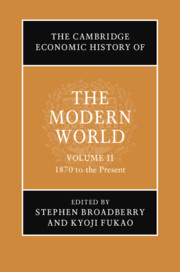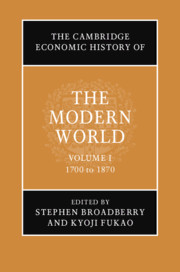Refine search
Actions for selected content:
26946 results in Economic history
Tables
-
- Book:
- The Cambridge Economic History of the Modern World
- Published online:
- 03 June 2021
- Print publication:
- 24 June 2021, pp xi-xiii
-
- Chapter
- Export citation
18 - Monetary Systems and the Global Balance of Payments Adjustment in the Pre-Gold Standard Period, 1700–1870
- from Part II - Factors Governing Differential Outcomes in the Global Economy
-
-
- Book:
- The Cambridge Economic History of the Modern World
- Published online:
- 03 June 2021
- Print publication:
- 24 June 2021, pp 438-467
-
- Chapter
- Export citation
Copyright page
-
- Book:
- The Cambridge Economic History of the Modern World
- Published online:
- 03 June 2021
- Print publication:
- 24 June 2021, pp iv-iv
-
- Chapter
- Export citation
Appendix 17.1 - Data sources for
- from 17 - International Transactions: Real Trade and Factor Flows
-
- Book:
- The Cambridge Economic History of the Modern World
- Published online:
- 03 June 2021
- Print publication:
- 24 June 2021, pp 436-437
-
- Chapter
- Export citation
Copyright page
-
- Book:
- The Cambridge Economic History of the Modern World
- Published online:
- 03 June 2021
- Print publication:
- 24 June 2021, pp iv-iv
-
- Chapter
- Export citation
Friends or foes? Brazil, the IMF and the World Bank, 1961–1967
-
- Journal:
- Financial History Review / Volume 28 / Issue 2 / August 2021
- Published online by Cambridge University Press:
- 21 June 2021, pp. 205-236
-
- Article
-
- You have access
- Open access
- HTML
- Export citation
Sowing the Seeds of a Future Crisis: The SEC and the Emergence of the Nationally Recognized Statistical Rating Organization (NRSRO) Category, 1971–1975
-
- Journal:
- Business History Review / Volume 95 / Issue 4 / Winter 2021
- Published online by Cambridge University Press:
- 15 June 2021, pp. 739-764
- Print publication:
- Winter 2021
-
- Article
-
- You have access
- HTML
- Export citation
Set and Forget? The Evolution of Business Law in the Ottoman Empire and Turkey
-
- Journal:
- Business History Review / Volume 95 / Issue 4 / Winter 2021
- Published online by Cambridge University Press:
- 14 June 2021, pp. 703-738
- Print publication:
- Winter 2021
-
- Article
-
- You have access
- HTML
- Export citation
The Emergence of the Swiss Tax Haven, 1816–1914
-
- Journal:
- Business History Review / Volume 96 / Issue 2 / Summer 2022
- Published online by Cambridge University Press:
- 10 June 2021, pp. 353-372
- Print publication:
- Summer 2022
-
- Article
-
- You have access
- Open access
- HTML
- Export citation

The Cambridge Economic History of the Modern World
-
- Published online:
- 03 June 2021
- Print publication:
- 24 June 2021

The Cambridge Economic History of the Modern World
-
- Published online:
- 03 June 2021
- Print publication:
- 24 June 2021
Figures
-
- Book:
- Making Commercial Law Through Practice 1830–1970
- Published online:
- 14 May 2021
- Print publication:
- 27 May 2021, pp xiii-xiv
-
- Chapter
- Export citation
Index
-
- Book:
- Making Commercial Law Through Practice 1830–1970
- Published online:
- 14 May 2021
- Print publication:
- 27 May 2021, pp 463-484
-
- Chapter
- Export citation
Note on Terms and Archives
-
- Book:
- Making Commercial Law Through Practice 1830–1970
- Published online:
- 14 May 2021
- Print publication:
- 27 May 2021, pp xix-xix
-
- Chapter
- Export citation
Dedication
-
- Book:
- Making Commercial Law Through Practice 1830–1970
- Published online:
- 14 May 2021
- Print publication:
- 27 May 2021, pp ix-x
-
- Chapter
- Export citation
Preface
-
- Book:
- Making Commercial Law Through Practice 1830–1970
- Published online:
- 14 May 2021
- Print publication:
- 27 May 2021, pp xv-xviii
-
- Chapter
- Export citation
Contents
-
- Book:
- Making Commercial Law Through Practice 1830–1970
- Published online:
- 14 May 2021
- Print publication:
- 27 May 2021, pp xi-xii
-
- Chapter
- Export citation
Table of Cases
-
- Book:
- Making Commercial Law Through Practice 1830–1970
- Published online:
- 14 May 2021
- Print publication:
- 27 May 2021, pp xx-xxxix
-
- Chapter
- Export citation
3 - Agents, ‘Agents’ and Agency
-
- Book:
- Making Commercial Law Through Practice 1830–1970
- Published online:
- 14 May 2021
- Print publication:
- 27 May 2021, pp 127-199
-
- Chapter
- Export citation
1 - Commercial and Legal Contexts
-
- Book:
- Making Commercial Law Through Practice 1830–1970
- Published online:
- 14 May 2021
- Print publication:
- 27 May 2021, pp 1-60
-
- Chapter
- Export citation
